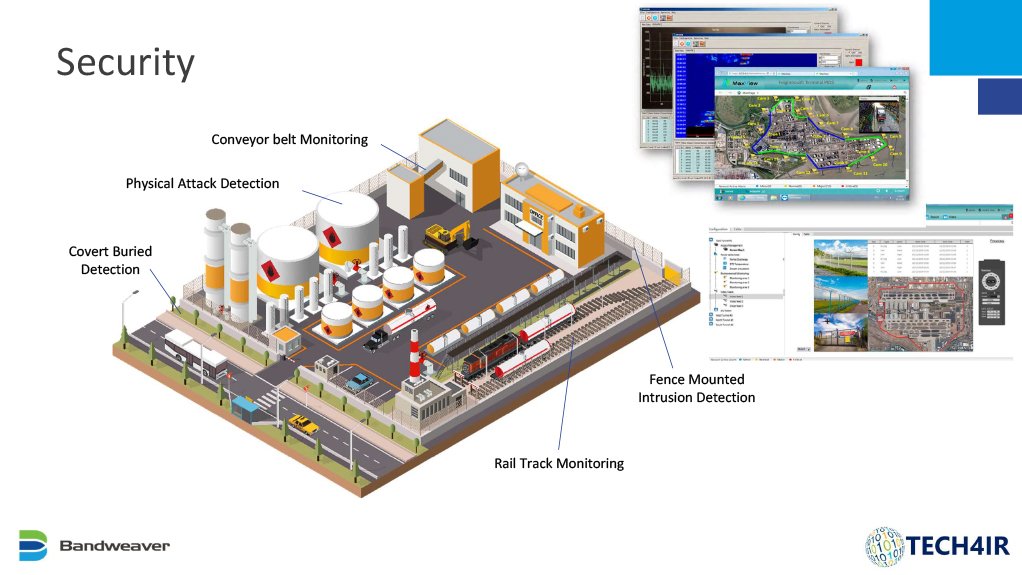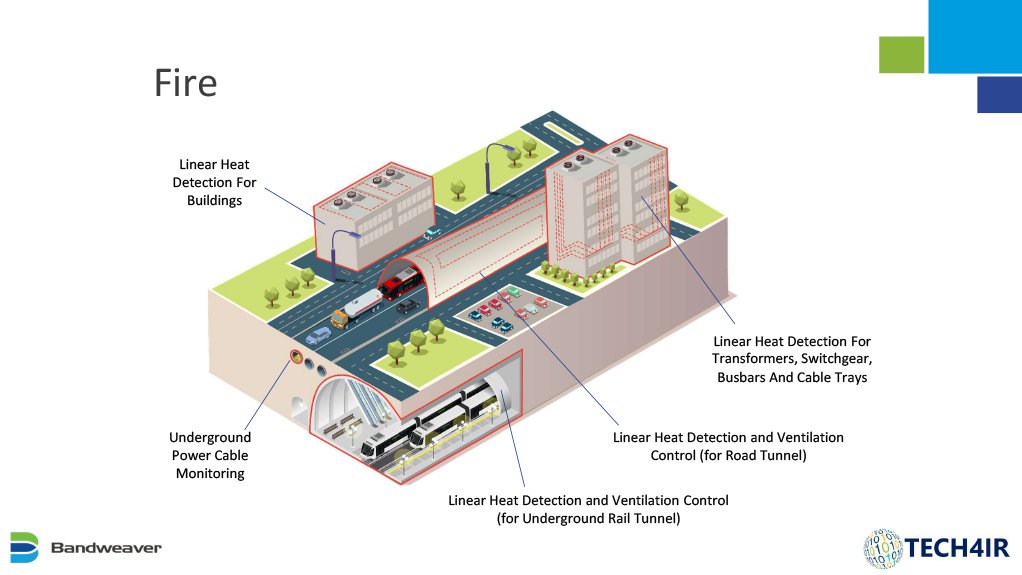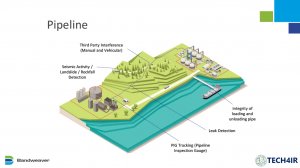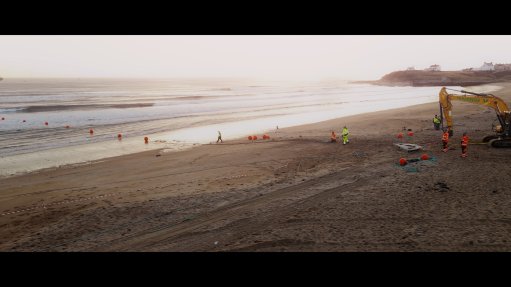Fibre sensing technology offers improved security for myriad of industries
Digital value chain solutions provider Tech4IR is aiming to leverage the versatility of its fibre sensing security application, to build a footprint of this technology in South Africa, and provide a safety solution to a wide spectrum of industries that are plagued by crime.
Speaking to Engineering News, CEO Andreas Matthee explains that Tech4IR focuses on monitoring, measurement, detection and building up insightful information that will benefit customers.
The company provides monitoring technology products, solutions on assets, including mobile rolling stock or fixed infrastructure, that it digitises into its cloud-based platform for automated analysis that is posited to create business and process enhancement and safety.
As alluded to, one particular technology that the company is bullish about making inroads into South Africa with is its fibre sensing technology, given that it can be used across various industries for security and conditions monitoring purposes.
Matthee explains that the technology is a continuous sensing device, which uses a fibre cable to sense acoustic signatures, and monitor transgression movements such as walking, knocking, banging, digging and moving vehicles within close proximity.
Owing to its smart artificial intelligent detection capabilities, the cable is able to detect any irregularities, by recognising normal patterns and differentiating these from transgressions, with this intelligence proficiency eliminating false alarms.
Tech4IR provides the technology solution of the sensing unit, fibre cable and the intelligent dashboard feature. The cable is installed underground along the requisite location, or looped around the required assets to be monitored (rolling stock or infrastructure).
Once an irregularity is detected, the cable sends a signal to the control room web-based dashboard and terminal, with a pinpoint location of where it occurred.
The information can also be relayed to entities like security companies through a smart interactive phone app, enabling those companies to respond accordingly.
Matthee explains that Tech4IR can recommend security companies it cooperates with to customers, however, they also have the option to use their own.
Moreover, the information can also be viewed in real-time on the web based app or dashboard terminal, allowing customers access to live movements and transgressions.
Further, there is a digitisation system which onboards the data within the cloud platform provided by Tech4IR, providing evolving ongoing automated analysis and associations which customers can access for deeper business insights and foresights.
Therefore, the use of this technology is posited to provide significantly more intelligence and coverage to the current types of conventional security measures such as drones or cameras, given that it mitigates some of the limitations that come with deploying these for security, such as an inability to cover a large area or blindspots.
In fact, the Tech4IR solution seamlessly integrates with 3rd systems, creating a more complimentary hybrid approach, that is in most cases automated for a more complete solution, Matthee acclaims.
He also affirms that there is no asset risk of the cable being stolen, as is the case with rampant copper cable theft in the country, given that the fibre material for this technology is of no value to criminals.
MULTIFACETED OFFERING
Notably, a selling point of this technology is that it boasts potential for a vast number of industries, ranging from railway lines and pipelines, to mining and other high-value infrastructure or rolling stock assets.
In terms of agriculture, examples of application range from games farms, where there are considerable problems such as rhino poaching; and pastoral farms, which have to contend with a scourge of cattle and other theft, as well as vandalism.
Matthee explains that owners and farmers can benefit from installing the fibre cable around certain perimeters of the farm, or around particular infrastructure, depending on their specific requirements, which can then monitor the area or assets.
Another industry is that of pipelines, with the technology able to assist in combating fuel theft.
In this instance, the cable can be run underground along the pipeline for long or short distances, and any movement impacting the pipeline can be monitored in real-time with an exact location, thereby immediately notifying security providers of any cutting or stealing, without the need for a camera, Matthee explains.
With regard to the rail industry, this technology has considerable application potential, Matthee acclaims.
For example, it can be deployed along the longitudinal length of the tracks for any amount of kilometres, thereby monitoring this infrastructure.
“Instead of putting up a physical fence, this cable can serve as virtual fence,” Matthee expounds.
The technology also has relevance closer to home, for example, it can be used to secure complexes, townhouses, zoning estates or even bigger areas; thereby offering up a potential alternative to electric fences, which come with caveats such as false alarms.
There is also the potential for smaller infrastructure, like cellphone towers, which are infamously the target of battery theft and communications companies having to spend considerable amounts of capital to mitigate this and fortify the asset.
The technology also has scope in mining, to be deployed around the parameters of mines, to monitor irregularity of movement to prevent transgressors; or around certain areas to prevent illegal mining from occurring.
Further, it can be also be installed on conveyor systems.
This is by no means an exhaustive list of the industries of application, as the technology can also be used in the steel, aviation and power industries or any industry with the applicable circumstances.
As mentioned, the technology can also be used for conditions monitoring, such as detecting hot and cold and temperature changes, thereby enabling features like fire detection and sending out an alarm expeditiously.
Matthee informs that the original equipment manufacturer of the technology, BANDWEAVER, which was founded some 20 years ago, now has a global footprint, with offices and test sites across the globe in the UK, US, Middle East and Asia.
More than 7 500 optical sensing systems are installed worldwide, which equates to over 60 000 km of fibre optic sensing distances being covered thus far.
This will now be further distributed and locally supported in South Africa through Tech4IR as the local representative.
While Tech4IR will be targeting all of the industries in which there is scope, agriculture will be its main thrust, given that the company sees the most potential for the technology here in the country.
Matthee says the company has been actively engaging with potential customers and market feedback has been “extremely positive”, with the company optimistic that the inaugural installation will be completed soon.
He notes that the biggest challenge in increasing adoption is raising awareness and educating people as to the options available to them.
In this vein, Tech4IR will be undertaking measures such as attending relevant exhibitions like security and fire trade exhibition Securex next year, to demonstrate the product principles of operation, improve awareness of the product and to further its market reach.
Matthee notes that while there are some viable competing technologies available in South Africa, smart detection systems is still an area in which the country is lagging.
Moreover, he acclaims that Tech4IR’s competitive advantage includes their “passion and energetic drive to significantly contribute to our country meaningful offerings together with our solid technical know-how, the aftersales local support in endeavours to provide, as well as the long-distance capabilities of the technology”.
“It's not a solution that solves every problem we face in South Africa, but it is a solution that solves the detection challenges along long distances. We can’t afford to not have real-time smart detection along long distances in our country, given our current situation, emphasises Matthee.
Article Enquiry
Email Article
Save Article
Feedback
To advertise email advertising@creamermedia.co.za or click here
Comments
Announcements
What's On
Subscribe to improve your user experience...
Option 1 (equivalent of R125 a month):
Receive a weekly copy of Creamer Media's Engineering News & Mining Weekly magazine
(print copy for those in South Africa and e-magazine for those outside of South Africa)
Receive daily email newsletters
Access to full search results
Access archive of magazine back copies
Access to Projects in Progress
Access to ONE Research Report of your choice in PDF format
Option 2 (equivalent of R375 a month):
All benefits from Option 1
PLUS
Access to Creamer Media's Research Channel Africa for ALL Research Reports, in PDF format, on various industrial and mining sectors
including Electricity; Water; Energy Transition; Hydrogen; Roads, Rail and Ports; Coal; Gold; Platinum; Battery Metals; etc.
Already a subscriber?
Forgotten your password?
Receive weekly copy of Creamer Media's Engineering News & Mining Weekly magazine (print copy for those in South Africa and e-magazine for those outside of South Africa)
➕
Recieve daily email newsletters
➕
Access to full search results
➕
Access archive of magazine back copies
➕
Access to Projects in Progress
➕
Access to ONE Research Report of your choice in PDF format
RESEARCH CHANNEL AFRICA
R4500 (equivalent of R375 a month)
SUBSCRIBEAll benefits from Option 1
➕
Access to Creamer Media's Research Channel Africa for ALL Research Reports on various industrial and mining sectors, in PDF format, including on:
Electricity
➕
Water
➕
Energy Transition
➕
Hydrogen
➕
Roads, Rail and Ports
➕
Coal
➕
Gold
➕
Platinum
➕
Battery Metals
➕
etc.
Receive all benefits from Option 1 or Option 2 delivered to numerous people at your company
➕
Multiple User names and Passwords for simultaneous log-ins
➕
Intranet integration access to all in your organisation

























